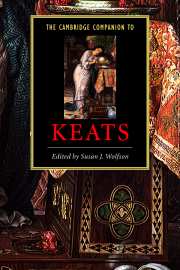Book contents
- Frontmatter
- 1 The politics of Keats’s early poetry
- 2 Endymion’s beautiful dreamers
- 3 Keats and the “Cockney School”
- 4 Lamia, Isabella, and The Eve of St. Agnes
- 5 Hyperion, The Fall of Hyperion, and Keats’s epic ambitions
- 6 Keats and the ode
- 7 Late lyrics
- 8 Keats’s letters
- 9 Keats and language
- 10 Keats’s sources, Keats’s allusions
- 11 Keats and “ekphrasis”
- 12 Keats and English poetry
- 13 Byron reads Keats
- 14 Keats and the complexities of gender
- 15 Keats and Romantic science
- 16 The “story” of Keats
- 17 Bibliography and further reading
- Index
4 - Lamia, Isabella, and The Eve of St. Agnes
Published online by Cambridge University Press: 28 May 2006
- Frontmatter
- 1 The politics of Keats’s early poetry
- 2 Endymion’s beautiful dreamers
- 3 Keats and the “Cockney School”
- 4 Lamia, Isabella, and The Eve of St. Agnes
- 5 Hyperion, The Fall of Hyperion, and Keats’s epic ambitions
- 6 Keats and the ode
- 7 Late lyrics
- 8 Keats’s letters
- 9 Keats and language
- 10 Keats’s sources, Keats’s allusions
- 11 Keats and “ekphrasis”
- 12 Keats and English poetry
- 13 Byron reads Keats
- 14 Keats and the complexities of gender
- 15 Keats and Romantic science
- 16 The “story” of Keats
- 17 Bibliography and further reading
- Index
Summary
Keats's final lifetime volume of poetry, published in the summer of 1820, is named for its three romances - Lamia, Isabella, The Eve of St. Agnes, and Other Poems - and the title page identifies the poet as “Author of Endymion,” his longest romance of all. Keats and his publishers sought to present him as a narrative poet on a literary scene dominated by popular writers of romances, such as Scott and Byron. This is remarkable, not only because Endymion had been ridiculed, but also because Keats himself had seemed intent to secure his name, like Homer or Milton, through epic. In Sleep and Poetry, the finale to Poems (1817), he imagined bidding farewell to the poetry of delight, “the realm . . . / Of Flora, and old Pan” (101-2), in order to treat “the agonies, the strife / Of human hearts” (124-25), matter for epic or tragedy. This pivot is most revealing, however, in projecting the way Keats's farewells to romance stay dialectically engaged with it. Even his last attempt at epic, The Fall of Hyperion (late 1819), begins in a romance setting, amid the remnants of an Edenic feast, and takes the form of a Dantean dream-vision, a motif from quest-romance. From the 1817 Poems, with its various gestures of romance (“Lo! I must tell a tale of chivalry,” begins Specimen of an Induction to a Poem), through Endymion, to the 1820 volume and after, Keats seems always on a quest to write a few fine quest romances.
- Type
- Chapter
- Information
- The Cambridge Companion to Keats , pp. 53 - 68Publisher: Cambridge University PressPrint publication year: 2001
- 7
- Cited by



